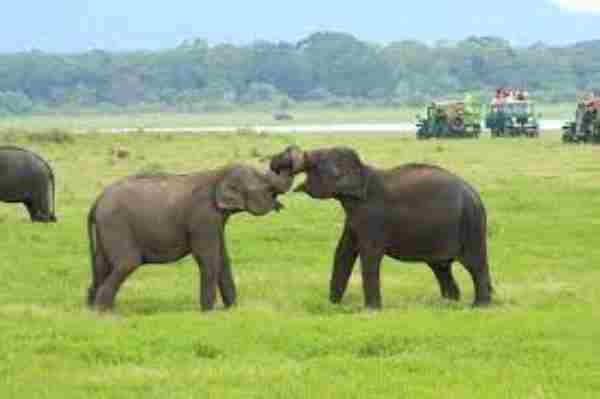In the enigmatic world of fauna, a select group of beings stands apart, showcasing cognitive abilities that transcend mere instincts. These extraordinary creatures possess a level of intelligence and understanding that rivals and, in some cases, parallels human capabilities. Welcome to the realm of sapient animals, where complex problem-solving, emotional depth, and communication prowess redefine our understanding of non-human minds.
From the crafty corvids and perceptive primates to the insightful cetaceans, the animal kingdom is peppered with remarkable intelligence. This article embarks on a fascinating journey to unravel the cognitive feats of sapient animals, offering insights into their astonishing mental faculties and the implications this has on our perception of intelligence, empathy, and the intricate tapestry of life that encompasses us all. Join us as we delve into the world of these exceptional beings, shedding light on the depths of their sapience.
Table of Contents
The Concept of Sapience: Unveiling Higher Intelligence in the Animal Kingdom
Sapience, a term often used interchangeably with sentience and intelligence, refers to a higher order of cognitive abilities beyond basic instincts. It encompasses reasoning, problem-solving, self-awareness, emotional intelligence, and an understanding of abstract concepts. This level of cognitive sophistication allows animals to adapt to complex environments, showcase learning and memory, and engage in behaviors that indicate conscious decision-making. The concept of sapience challenges traditional perceptions of animal minds, raising questions about the true extent of their cognitive capabilities and the ethical considerations surrounding their treatment.
Evidence of Sapience in Animals: A Glimpse into Animal Minds
Across various species, compelling evidence of sapience emerges. Corvids like ravens and crows exhibit exceptional problem-solving abilities, tool usage, and even an understanding of cause and effect. Primates, particularly chimpanzees, and orangutans, demonstrate advanced problem-solving skills, social learning, and tool creation. Dolphins exhibit complex communication and cooperation, showcasing an understanding of abstract symbols. These manifestations of higher intelligence in animals prompt us to reconsider our understanding of cognition and consciousness beyond the human sphere.
Chimpanzees (Pan troglodytes):

Chimpanzees, our closest living relatives, demonstrate remarkable sapience. They possess advanced problem-solving abilities, exhibit tool usage to obtain food navigate their environment, and showcase complex social behaviors. Chimpanzees display traits such as empathy, altruism, and cultural learning within their communities, providing insights into their sophisticated cognitive capacities. Their ability to communicate using sign language or symbols underscores their linguistic and communicative intelligence, making them a subject of extensive study to better understand the origins and nature of human cognition.
Dolphins (Delphinidae):

Dolphins, highly intelligent marine mammals, are known for their complex social structures and sophisticated communication systems. Their exceptional problem-solving skills, capacity for mimicry, and ability to comprehend and follow human instructions highlight their cognitive prowess. Dolphins use a combination of vocalizations, body language, and echolocation for communication and navigation. Their self-awareness, creativity, and ability to learn from their environment contribute to their status as sapient beings in the aquatic realm, sparking fascination and ongoing research into their cognitive capacities.
Elephants (Elephantidae):

Elephants, with their extraordinary memory and intricate social structures, showcase a high degree of sapience. Their ability to exhibit empathy, altruism, and self-awareness, as demonstrated by recognizing themselves in a mirror, signifies a complex level of cognition. Elephants display problem-solving skills and an impressive understanding of their environment, including the ability to navigate vast landscapes in search of food and water. Their sophisticated communication through vocalizations, infrasound, and body language further establishes their social intelligence. Ongoing research sheds light on the extent of their cognitive abilities, emphasizing the need for conservation efforts to protect these intelligent and majestic creatures.
African Grey Parrots (Psittacus erithacus):

African Grey Parrots, celebrated for their exceptional intelligence among avian species, showcase remarkable sapience. They possess an extensive vocabulary and can use words contextually, displaying a deep understanding of human language. Not only can they mimic human speech, but they also exhibit problem-solving skills and cognitive flexibility. African Grey Parrots can understand and respond to complex instructions, showcasing their ability to engage in advanced learning and communication. Their cognitive abilities continue to astound researchers, elevating them to a prominent position in the study of animal intelligence.
Octopuses (Octopus):

Octopuses, despite being invertebrates, exhibit astounding cognitive abilities. With a highly developed nervous system, they display complex problem-solving skills, learning capabilities, and the ability to adapt to various environments. Octopuses have demonstrated remarkable feats of intelligence, such as opening jars to access food, solving mazes, and employing impressive camouflaging and mimicry techniques for both hunting and avoiding predators. Their cognitive prowess challenges traditional notions of intelligence and underscores the diversity of sapience across the animal kingdom.
Orangutans (Pongo):

Orangutans, the largest arboreal primates, demonstrate a high level of sapience. Their problem-solving abilities, tool usage, and sophisticated social behaviors set them apart. Orangutans exhibit innovative ways to extract and consume food, showcasing their intelligence and adaptability. They possess the ability to learn from past experiences, employ strategic thinking, and display a level of self-awareness. These great apes display empathy, altruism, and even cultural learning within their communities. Studying orangutans offers valuable insights into the evolution of cognitive traits shared with humans.
Pigs (Sus scrofa domesticus):

Pigs, often underestimated in terms of intelligence, surprise researchers and animal behaviorists with their high level of sapience. They exhibit advanced problem-solving skills, adaptability to new environments, and an impressive memory. Pigs are fast learners and can understand simple commands, using their intelligence to navigate their surroundings and even manipulate objects. Their social interactions and ability to communicate with other pigs further emphasize their cognitive capacities. Continued research sheds light on the extent of their intelligence and challenges preconceived notions about animal cognition.
New Caledonian Crows (Corvus moneduloides):

New Caledonian crows are renowned for their extraordinary problem-solving abilities and innovative tool-making skills. They use tools to obtain food, showcasing their advanced problem-solving capabilities and adaptability. These crows exhibit an understanding of cause and effect, displaying an impressive level of cognitive flexibility. Their ability to fashion and modify tools to suit different tasks underscores their high intelligence and innovative thinking. New Caledonian crows continue to intrigue researchers, offering valuable insights into the cognitive evolution and abilities of avian species.
Parrots (Various species):

Parrots, encompassing various species, are celebrated for their remarkable intelligence and complex vocalization abilities. Their extensive vocabularies, comprehension of human speech, and capacity to mimic sounds and words highlight their cognitive prowess. Parrots can associate words with meanings and use them in context, displaying a deep understanding of language. They demonstrate problem-solving skills, creativity, and adaptability in their environments. Ongoing research into parrot cognition continues to reveal the depths of their intelligence and communication abilities, establishing them as a fascinating subject in the study of animal sapience.
Bottlenose Whales (Hyperoodon spp.):

Bottlenose whales, a group of deep-diving cetaceans, exhibit sophisticated vocalizations and complex social behaviors. Their communication, which involves a variety of clicks and whistles, emphasizes their advanced cognitive abilities. These whales display a high level of self-awareness and possess an understanding of their environment and pod dynamics. Ongoing studies on bottlenose whales aim to uncover more about their cognitive capacities, shedding light on the intelligence and social intricacies of marine mammals.
Bonobos (Pan paniscus):

Bonobos, closely related to chimpanzees, showcase advanced cognitive abilities and a sophisticated social structure. Known for their peaceful and cooperative behavior, bonobos utilize complex communication, including vocalizations and body language, to express emotions and intentions. They exhibit problem-solving skills and have displayed tool usage in various contexts. Bonobos possess a high level of social intelligence, employing empathy, compassion, and conflict resolution within their communities. Studying bonobos provides valuable insights into the evolutionary origins of human behavior and cognition, emphasizing the importance of understanding our primate relatives.
Gorillas (Gorilla):

Gorillas, the largest primates, demonstrate a high degree of intelligence and complex social behaviors. Their ability to communicate using vocalizations and body postures, along with an understanding of their social hierarchies, underscores their cognitive capabilities. Gorillas display empathy, altruism, and problem-solving skills, adapting to changes in their environment and demonstrating tool usage. Ongoing research into gorilla cognition sheds light on their mental capacities and enhances our understanding of primate intelligence and the intricate dynamics within gorilla communities.
Cetaceans (whales and porpoises):
Cetaceans, a group that includes whales, porpoises, and dolphins, possess impressive cognitive abilities and social complexity. They exhibit sophisticated communication, often using intricate vocalizations and body language to convey information and maintain social bonds. Cetaceans showcase problem-solving skills, memory, and cultural learning, passing knowledge down generations. Their capacity for empathy, altruism, and cooperation within their pods demonstrates a high level of social intelligence. Ongoing research into cetacean cognition offers profound insights into their intricate underwater lives, highlighting the importance of marine conservation and our understanding of these sentient beings.
Ethical and Conservation Considerations: Reshaping Our Relationship with Sapient Animals
The acknowledgment of sapience in animals carries significant ethical implications. It challenges traditional views that justify the use of animals solely for human benefit. As we grasp the depth of their cognitive abilities and emotional range, our moral responsibility towards them amplifies.
Ethical considerations extend to how we treat sapient animals in research, agriculture, entertainment, and captivity. Conservation efforts should also integrate an understanding of animal sapience to ensure the preservation of not just species, but the unique cognitive heritage within them.
The Future of Understanding Sapience in Animals: Bridging Gaps in Knowledge
The future of understanding sapience in animals rests on interdisciplinary research, integrating fields like biology, neuroscience, psychology, and ethics. Advances in technology, including neuroimaging and behavioral studies, will provide deeper insights into animal cognition.
Moreover, fostering public awareness about animal intelligence and the ethical treatment of sapient animals will drive change in policies and societal attitudes. Collaboration between scientists, conservationists, policymakers, and society is crucial in evolving our comprehension of sapience in animals and translating that knowledge into actions that uphold the dignity and rights of these remarkable beings.
Final Word: Nurturing Compassion and Respect for All Life Forms
Understanding and acknowledging the sapience of animals broadens our horizons, reminding us that intelligence and consciousness are not exclusive domains of humans. It urges us to treat animals with compassion, respect, and empathy.
As we navigate this realm of expanded understanding, let it guide our actions, policies, and choices towards a world where all life forms coexist harmoniously, and where our collective wisdom is marked by a deep reverence for the magnificent diversity of life that graces our planet. Ultimately, embracing sapience in animals is an invitation to nurture a world imbued with empathy, kindness, and a profound appreciation for the beauty of every sentient being.
Reference:
https://uk.whales.org/whale-culture/sentient-and-sapient-whale-and-dolphins/
https://www.differencebetween.com/what-is-the-difference-between-sentient-and-sapient/
A motivated philosophy graduate and student of wildlife conservation with a deep interest in human-wildlife relationships, including wildlife communication, environmental education, and conservation anthropology. Offers strong interpersonal, research, writing, and creativity skills.










